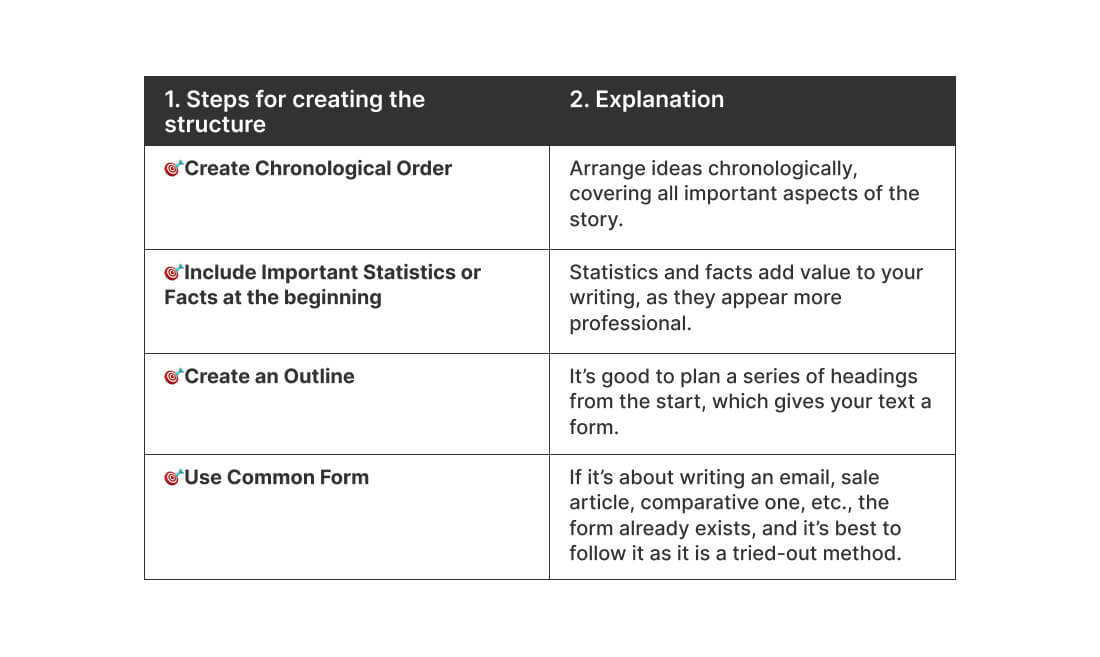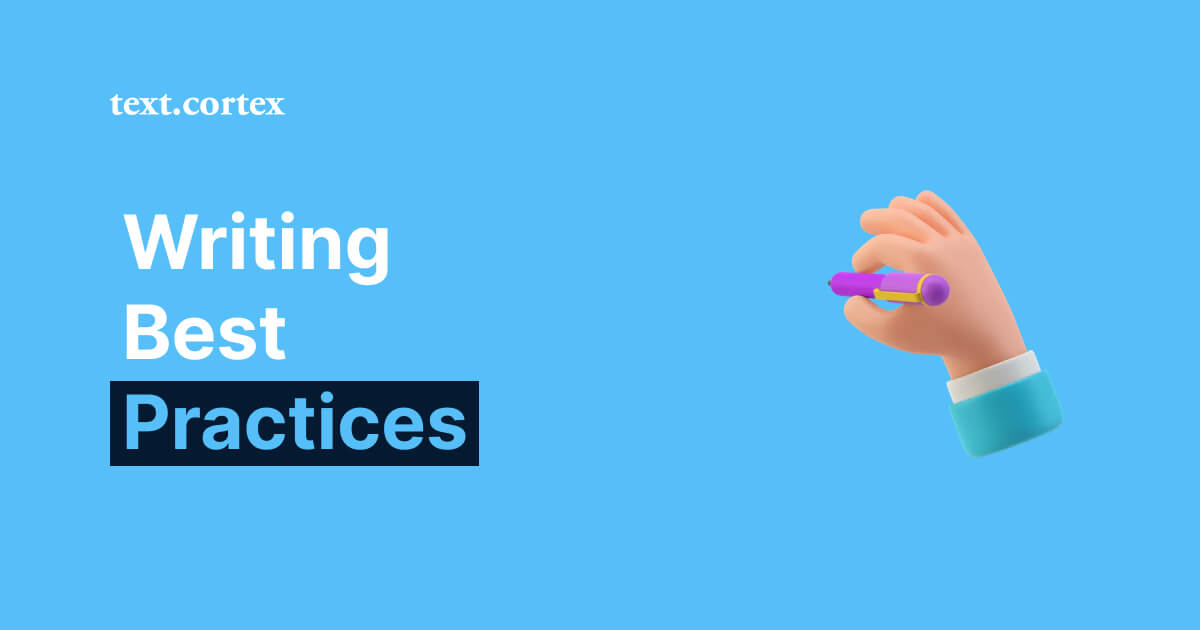Have you ever been inspired only to realize your work isn't comprehensible or fascinating at all the next day?
It happens to professional writers regularly as well as to those who are just starting.

For whatever purpose you create content, you want the audience to react positively.
This is when tried-and-true writing techniques come into play, enabling you to produce great content.
In this post, we'll review the 6 best practices for writing to assist you in improving your writing skills for the future!
Why Is It Vital to Use Best Practices When Writing?
You might think your imagination solely drives the writing process with inspiration.
That has some validity because you need authentic writing to draw readers in the first place.
However, you won't advance in the end if you don't follow some form and procedure when producing your content.
The following are the actual benefits of using best writing practices:
- Responding to the needs of your viewers.
- Increasing the number of readings and creating a community.
- Improving brand awareness and generating organic traffic
With a few writing rules in place, you can write better and get results more rapidly.
Let’s see what are the best practices for writing!
6 Best Practices to Write Content That Readers Think About Days After
1. Set an End Result
Before you start writing, think of a result.
There needs to be a clear objective, whether getting your professor to agree to your request or encouraging readers to visit the site for which you write blogs.
Here are some questions to ask yourself before writing:
- Who is my audience? What is specific about them?
- How can I grab their attention? What is the hook?
- Which message do you want to convey and in which tone?
- Which content do I need to cover? What is all the important information I need to include?
After you consider these questions and jot down the responses, the text will naturally flow, and you'll have all the crucial information at hand as you write.

By answering these questions, you have half of the job already done.
2. Create an Understandable Structure
Be sure to arrange your thoughts before writing the post as a whole.
The organization of the written text aids in its reader's ability to understand it and find it visually appealing.
Here are some steps for creating a structure that makes sense.

By following these guidelines, you can prevent yourself from sinking in your thoughts and instead communicate all that is significant and adds value to the content.
💡Pro Tip
With TextCortex’s ZenoChat feature, you can easily create an outline or use it to give you a brief idea of how to put your paragraphs into sections.
Prompt ZenoChat with your topic and ask it to create an outline for you.
Further, you can give it additional prompts or edit what it creates per your taste.
Note: It can help you create content without plagiarism - all you need to do is ask.
3. Set Adequate Tone
To set an adequate tone, it's important to choose your words carefully and to be mindful of how you want your reader to respond.
🌸Consider the Emotion You Want to Convey
Do you want to inspire action? Persuade someone to your point of view?
Or do you simply want to provide information? Tailor your tone to suit your goal.
For example:
Inspirative tone: "Success is not determined by your circumstances, but rather by your attitude towards them. Keep pushing, stay focused, and never give up."
Providing information clearly: "The event will take place on May 1st at 5:00 pm at the main conference hall. Please arrive at least 15 minutes early to check in."
Persuading someone: "Investing in our product will not only benefit your business but also save you time and money in the long run.”
🌸 Use Active Voice
Avoiding passive voice is essential in writing because it can make sentences more difficult to understand and less engaging for readers.
On the other hand, the active voice makes writing clearer and more direct, giving it a more substantial impact.
For example:
Active: "The company issued a statement."
Passive: "A statement was issued by the company."
🌸Include Call To Actions
Calls to action (CTAs) are vital because they prompt the reader to take a specific action after reading a piece of content.
They serve as a guide for the audience and give them a clear next step.
Without a CTA, the reader may not know what to do or won’t take any action.
For example:
"Buy now,"
"Sign up,"
"Learn more,"
"Get started today."
The importance of CTAs lies in the fact that they help direct reader behavior, which can encourage engagement.
The reader is more likely to accomplish what you want if you make your expectations obvious to them.
💡Pro Tip
TextCortex helps you create a digital persona according to your needs.
Provide brief information and instructions, and create a persona that will write everything based on your input and style.
Additionally, you can use one of the 15+ existing persona templates.
4. Hook Your Readers
Hooks are a vital tool for writers to capture and hold readers' attention.
They capture the reader's interest and encourage them to read more.
A question, an unexpected fact, a quote, or any other attention-grabbing element that establishes the tone for the rest of the piece might serve as a hook.
For example:
Starting an article on climate change with the startling statistic:
"Every minute, the equivalent of one garbage truck of plastic enters our oceans."
Or using a rhetorical question as a hook, such as:
"Have you ever wondered what it would be like to travel back in time?"
Furthermore, consider how you want your hooks to address the following essential points:

💡Pro Tip
TextCortex offers a hook generator tool that creates attention-grabbing hooks in seconds.
You only need to enter the essay title, and the tool will provide a whole column of possible hooks.
Furthermore, you can specify which type of hook you want: inspirational, argumentative, etc.
5. Be Concise and Clear
Effective message communication depends on your ability to write simply and concisely.
Here are some essential suggestions and methods for best writing practices:
🌸Have a Clear Message
Once you have a clear concept, try to express it in short, concise lines.
Keep your message throughout the piece, and proofread your work to make sure nothing additional is there.
🌸Use Simple Language
Don't let lengthy, intricate sentences make the reader lose interest.
They will get lost, and writing will have a messy appearance.
It's important to use language that is appropriate for the issue you are writing about while keeping it simple. That will hold the reader’s interest and encourage them to read more.
🌸Get to the Point Quickly
Save readers' time with long paragraphs or pointless background material.
Describe the subject and include only the necessary details to meet the audience's needs.
🌸Use Formatting
Formatting guarantees that readers can quickly scan headings, subheadings, and additional sections to discover what they're looking for while making your work readable.
💡Pro Tip
The TextCortex's paraphrasing feature can help you modify long paragraphs into shorter but more interesting sections.
All you need to do is paste the text into the text box, and TextCortex will paraphrase it.
Additionally, the tool provides you with more than 25 languages, so you do not have to limit yourself to one.
6. Proofread and Edit
This final step ensures that your work is error-free and polished.
You should take a break between writing and proofreading to proofread and edit your work effectively. This way, you will catch more mistakes.
You can also read your work out loud to catch any awkward sentences or phrases.
Check for clarity in your writing, ensuring that your message is easy to understand and well-articulated.
Additionally, take constructive feedback from others, such as friends or colleagues, and use it to improve your work.
By taking time to remove grammatical errors, you will appear more professional.
💡Pro Tip
TextCortex provides you with error-free text. Since it uses natural language processing, it detects grammatical or spelling errors.
If you paste your text into the text box, you can expect the tool to look for errors and let you know about them and fix them.
Let’s Wrap Up
This whole article was about small and big tips on improving your writing style and increasing the likelihood of good results.
Writing is not as simple as just having a pen and a blank paper, but it takes some hard work to apply the best writing practices properly and effectively.
Do not be afraid, not everything is lost! There is a solution to overcome writer’s block and facilitate the writing process.
Let us introduce you to TextCortex!
How TextCortex Can Help You With Writing?
TextCortex, an AI-powered solution, allows you to simplify the writing process and improve your weak points while offering other powerful tools.
This clever AI tool offers features to improve your writing style to the next level.
With TextCortex, you can:
🔥 Establish your knowledge base and easily arrange files, files, and articles in one centralized spot, which cuts time searching for data.
🔥 Paraphrase, rewrite, and summarize text with AI Editing Tools.
🔥Customise personas according to your unique traits and present yourself as a professional writer.
🔥 Create emails from as few as three bullet points.
🔥 Use ZenoChat to help you with different tasks, from creating text to modifying the existing ones.
🔥 Craft content in a matter of seconds.
Why not give it a try?
Sign up for a freemium account to get 20 free content creations per day and try the platform's features for yourself.
Keep Learning
How Can Content Writing Tools Change The Way We Write Content?




